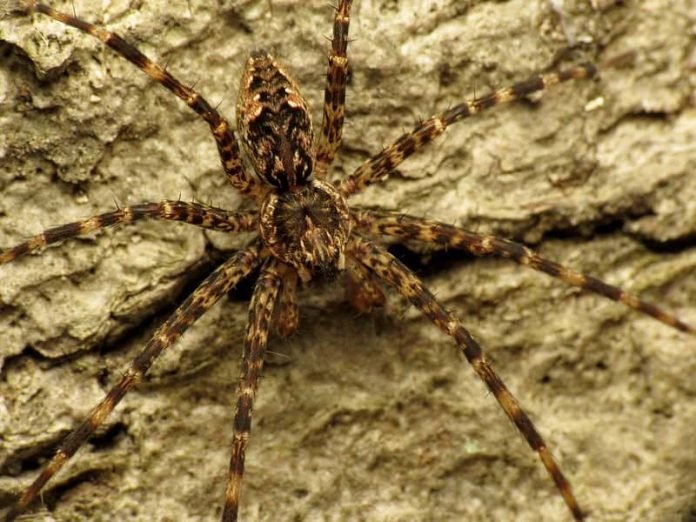
As long as it’s your tee or those swanky jeans, stripes are quite a common occurrence. Beyond that, and especially in the animal kingdom, stripes can be a bizarre yet fascinating phenomenon.
Now fuse stripes with spiders – Surprising, right? We are so used to those beige, monotonous-looking house spiders that it’s almost unusual to come across spiders with stripes.
So, here’s a list of 15 spiders with stripes. Some of these are venomous, and some are not, so just in case you ever come across a fascinating striped spider, you’ll want to keep your hands to yourself.
Here you go…
1.Fishing Spider
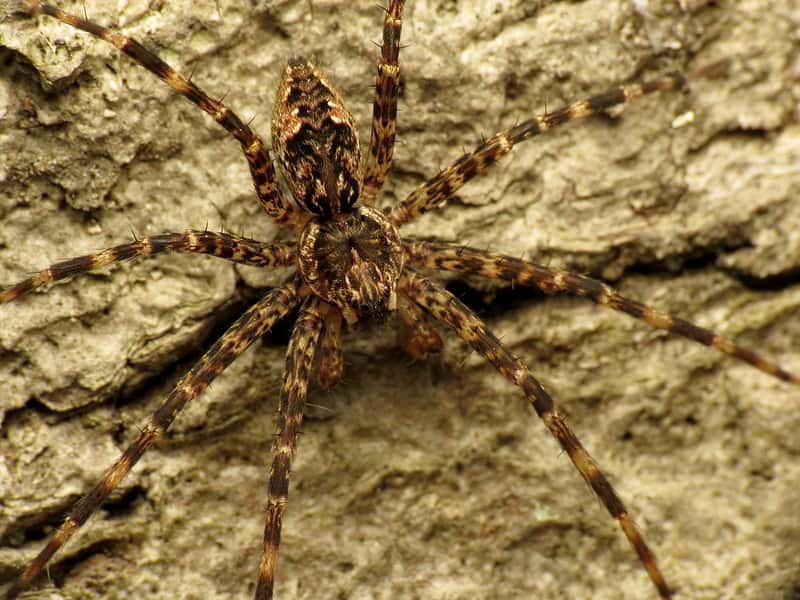
Fascinating yet intimidating, Fishing Spiders have a typical brown-colored body with black and light brown markings, and they have brown and black banded rings on their legs. They have white trim and six distinct spots on their abdomen. Some of them have dark stripes down their abdomen.
These spiders have tiny fine hairs on their body and legs. With these hydrophobic hairs, they walk freely on the surface of the water. The average size of these spiders is 3 inches long, including their legs and body.
Having a unique eye arrangement with three rows of eyes, Fishing Spiders’ first row has four eyes in a straight line, a large forward-facing pair in the middle, and a slightly smaller pair in the bottom row.
Fishing Spiders are venomous, and their mild toxic poison is harmful to tiny insects and creatures. The poison is completely harmless to humans unless you are specifically allergic to that poison.
It’s smart to steer clear of them, anyway.
Fishing Spiders are usually found near water bodies like lakes, ponds, marshes, rivers, streams, and woods. Some Fishing Spiders can also be found in the forests, hiding and searching for prey in bushes and plants. Fishing Spiders are generally found in the USA and Canada@. However, they are also found in other parts of the continents, except for Antarctica.
2.Golden Silk Orb-Weaver Spider
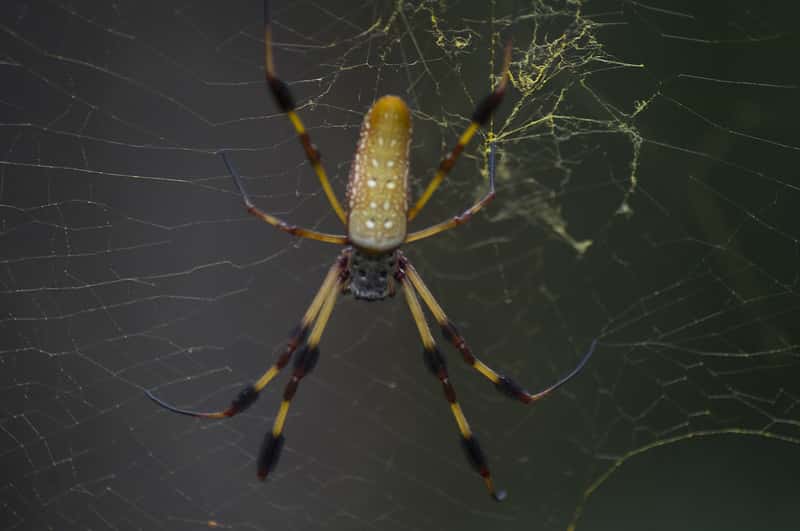
Golden Silk Orb-Weaver Spider is one of the largest species in the world. No, @Karen, they don’t beat the Tarantulas!
Their cylindrical body has unique color patterns consisting of silvery carapace and yellow spots. Orb-Weavers have striped legs banded with brown and orange color. The color of their body varies from reddish to greenish-yellow color. Their average size is between 1.5-2in excluding the leg span. The she-weavers are larger in size as compared to the males.
Though they look intimidating, they aren’t aggressive, and their venom is potent, but it is not lethal to humans. The bite may cause blisters, redness, and pain, which disappear after some time.
In other terms, they might ruin your day or a few days at most. You wouldn’t want that!
Golden Silk Orb-Weaver Spiders prefer to live in warm regions, and they thrive on high humidity and open spaces. They are commonly found in the United States, from North Carolina to Texas. They can also be found in warmer regions of Africa, Asia, and Australia.
3.Wolf Spider
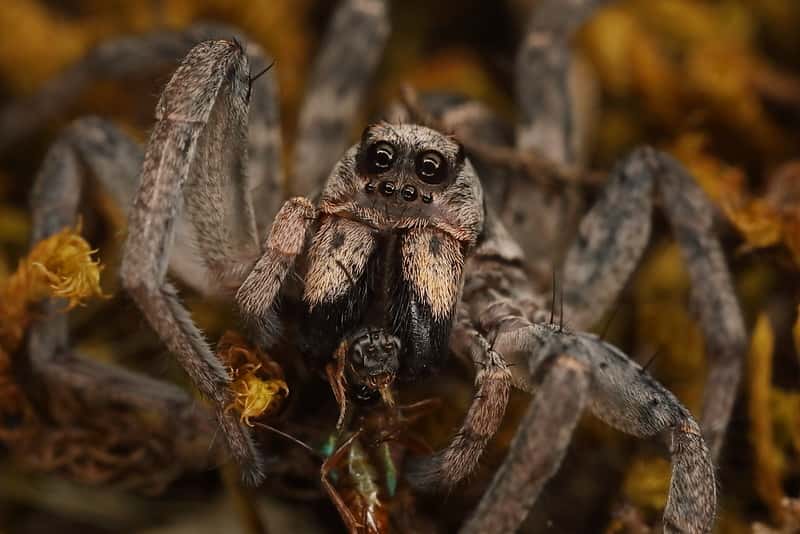
A Wolf Spider generally has a brown, gray, black, or tan-colored body with dark markings and stripes on them. Their average body size is 0.5-2.5 cm long, excluding their legs.
Harnessing excellent eyesight, their eight eyes are arranged in three rows. The top row has a pair of medium-sized eyes; the middle row has a pair of very large eyes and four small eyes in the bottom row. Wolf spiders, as their name suggests, have their body covered with tiny hairs, which includes long legs.
The venom of a Wolf Spider isn’t dangerous for humans, but it may cause skin ulceration which is known as necrotic arachnidism. It is caused due to the bacteria infecting the bite instead of the actual venom.
Enough with the biology lesson!
Wolf Spiders occupy a wide variety of habitats which include mainly the open woodlands, grasslands, and forests. You can find their burrows in the areas around the doors and windows of your houses and other buildings. They are known to be sweeping across the UK, and this eight-legged creature is native to North America.
4.Zebra Spider
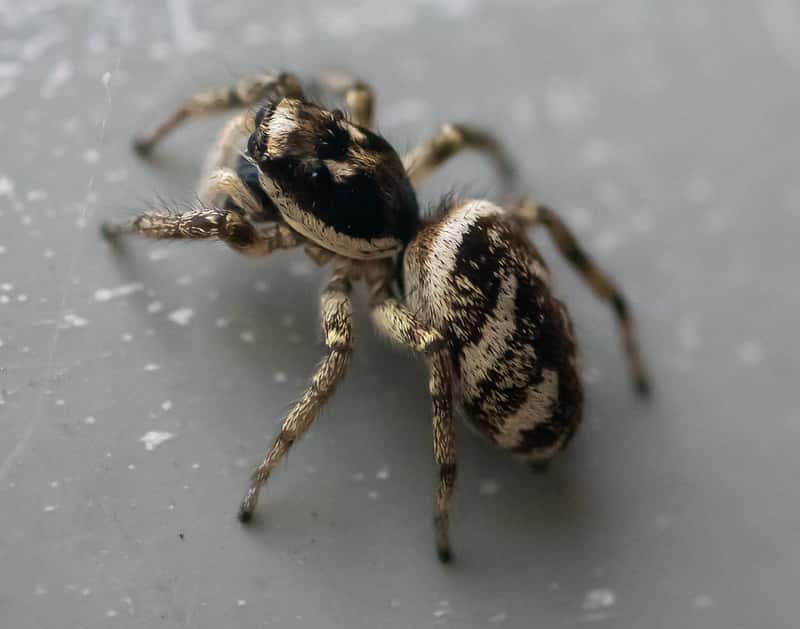
Zebra Spider, as its name suggests, has the Black and White stripes familiar to a zebra. Of course!
They have gray rings on their white or brown legs. They are small and sturdy spiders with an average body length of 5 to 7 mm long and fairly short legs. These amazing jumping spiders can jump to a height more than 14 times their own body length.
Oh, and they are blessed with truly remarkable eyesight – the front pair of eyes are large, and they look impressive; the other 6 eyes are positioned around the head, which provides them a 360-degree vision.
Zebra Spiders are not aggressive biters; they do release venom to subdue their prey, but this venom is not harmful to humans. It only causes mild irritations and, in some cases, minimal injury, which can be easily cured.
Due to their excellent agility and swift reflexes, they prefer hunting for prey during the daytime with ample sunlight. They prefer outdoor environments with plentiful vegetation and sufficient sunlight. Zebra Spiders can be found in large numbers across Britain, Europe, and North America.
5.Yellow Garden Spider
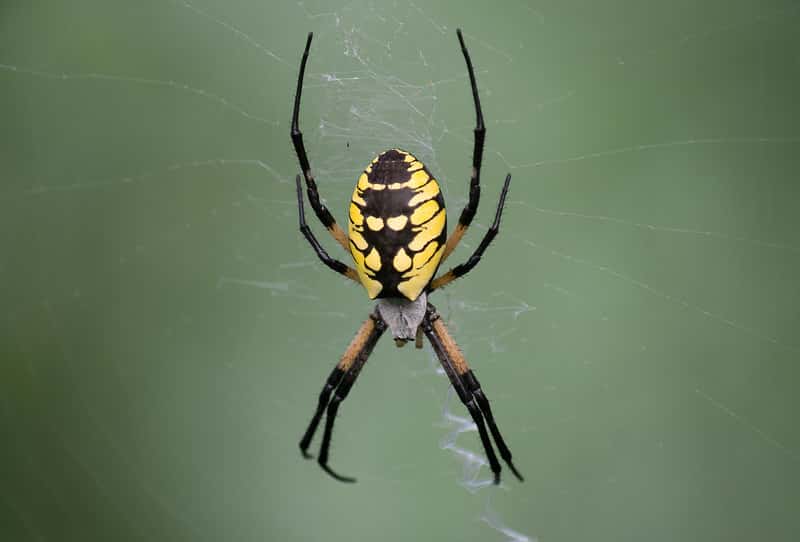
Yellow Garden Spiders are large orb-weaving spiders; they are also known as writing spiders due to the zigzag pattern in their webs.
You can expect a book by next year!
The adults are sexually dimorphic; the females are bigger in size than the males. The average size of a female is 14-24mm, and the size of a male is less than 6mm.
Females can be easily identified by the bands of yellow and black on their carapace, and their eyes are covered with tiny silver hairs. The males are small and brown in color with enlarged and swollen pedipalps.
The venom that these spiders produce is used to paralyze their prey like flies, bees, and other flying insects. But this venom is completely harmless to humans, and they don’t bite unless disturbed.
Yellow Garden Spiders prefer areas with sufficient sunlight, bushes, gardens, and other supporting structures where they can anchor their large orb webs. They are native to North America, and they are found throughout Canada, Mexico, and Central America.
6.Wasp Spider
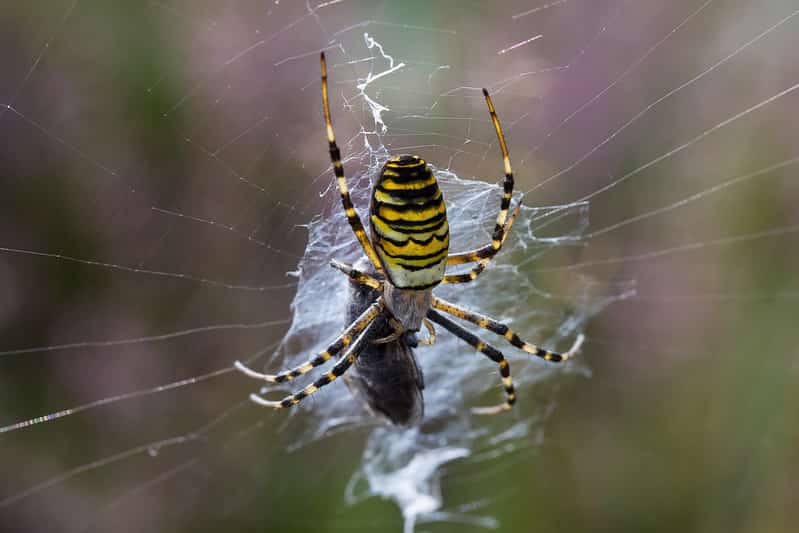
Wasp Spider got its name for black and yellow stripes across its body, and these colors and patterns are familiar to the coloration of a wasp.
Their wasp-like appearance works as a defense mechanism keeping them safe from predators. In simple terms, it leaves them nasty predators, believing that these clever (apparently) creatures are wasps.
One can easily differentiate between a female and a male wasp spider by its size. The females have an impressive 14-17mm size, whereas the males only reach between 4-6mm.
Wasp Spiders aren’t poisonous, but they are capable of biting a human. The bite hurts due to fang insertion, but it doesn’t cause any serious risks.
Wasp Siders require places with taller vegetation to support their webs. They prefer to live in grasslands, farmlands, woodland, and gardens. They are native to Mediterranean areas, and they are found in large numbers throughout Europe, Africa, and Asia.
7.Giant Water Spider
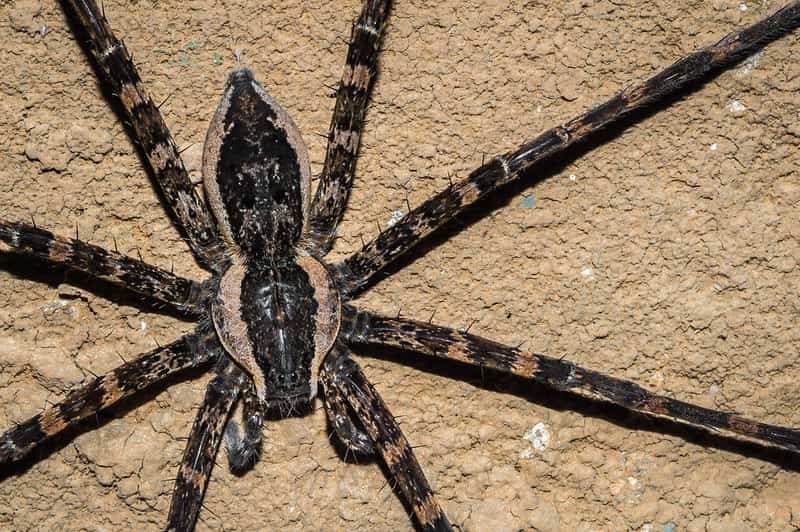
As their name goes, Giant Water Spiders are regarded as one of the largest hunting spiders you have found near water. They have unique and prominent stripes with speckled patterns all over their body along with tiny hairs, which traps air bubbles in the water and provide them with a shimmering and silvery appearance. An adult water spider has an average size between 8-15mm.
They aren’t dangerously venomous; their venom is effective only on small vertebrates. The adults have large fangs, and when disturbed, they give a painful bite which might cause redness and blisters but nothing serious.
Water Spiders are usually found near ponds, slow-running waters, and other shallow water bodies, where they find abundant aquatic vegetation. They are distributed in huge numbers in the Eastern part of Australia.
8.Brown Widow
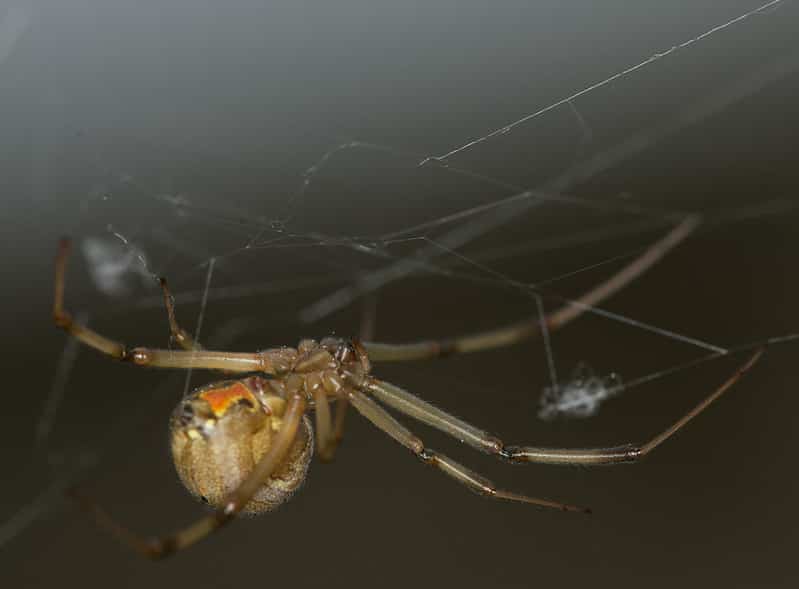
A Brown Widow spider resembles the Black Widow spider, but their hourglass is yellowish-orange or reddish-orange in color, unlike the Black Widow, which has a bright red colored hourglass.
Brown Widows also have banding and light coloration on their legs which is visible even in the darkest colors of the individual spiders. Their coloration also has mottling of tan and brown with black accent markings. The average size of a mature female is 1-1.5 inches long, whereas the males grow to a maximum height of 0.5-0.8 inches.
Due to its small size, the Brown Widow is unable to inject much venom, unlike its larger relative. Since they cannot inject venom very much, they become less dangerous.
They are shy too, so they don’t usually bite until disturbed; they stay still and avoid human interaction. Their bite causes pain at the bite site and red marks, and one should seek medical treatment immediately.
Brown Widows are subtropical spiders found in a huge population in Hawaii, Florida, North America, Japan, and Cyprus. These spiders are found in the corner of man-made structures like houses, barns, and fences.
9.Jorō spider
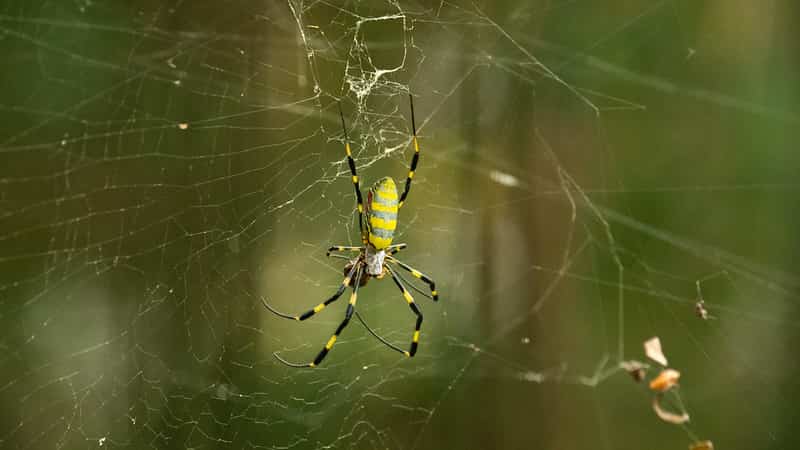
The female Jorō spiders have bluish-green stripes on their yellow-colored body with red markings on their abdomen, whereas the males are dull brown colored. Their black legs are impressively striped in yellow. Female Jorō spiders have an average body size of 17-25mm, and the males have a 7-10mm body size.
Though they have a fearful look, they aren’t dangerous. Their bite results in redness, blisters, and pain which is equal to a bee sting. And it is not a serious concern unless you have severe allergies.
They are commonly found and spread all over China, Korea, Japan. Living in subtropical forests and man-made buildings, these spiders can usually be found at places like houses, fences, and other structures.
10.Mexican Redknee Spider
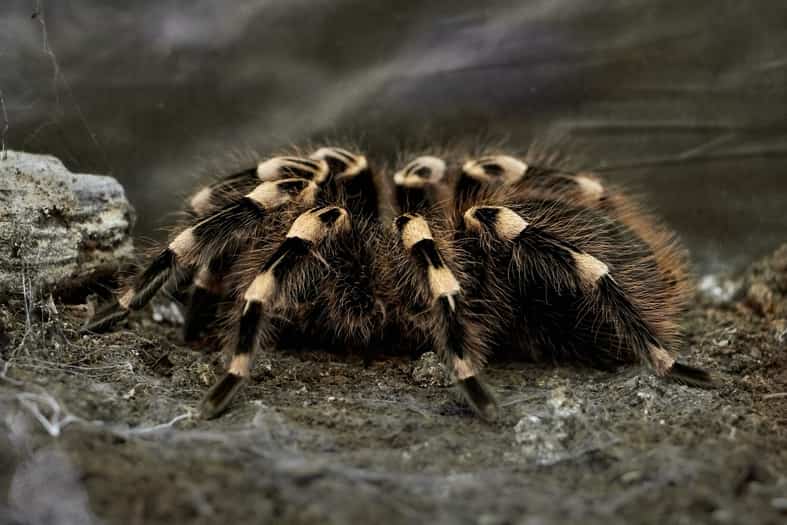
The well-known Mexican RedKnee Spiders have a black-colored body with their bodies partly covered with brown hairs. They have red bands on their leg joints. Yes, it is indeed the reason behind their name.
Their creamy beige-colored carapace also has a black square. The size of these dark and large spiders varies between 12-14cm in length. These spiders have sexual Dimorphism, which means that the female spiders are larger than the male spiders in size. And the average lifespan of the females is typically 25-30 years, whereas the males live for less than 10 years.
Despite their fearful and intimidating appearance, these spiders are docile, and they bite only when they are threatened or disturbed. Their venom is harmless to humans, and the bite is equivalent to a bee sting.
Mexican red knee tarantulas inhabit dry areas with little vegetation like scrubland, deserts, dry thorn forests, and tropical forests. They are found throughout the Mexican states in large numbers.
11.Striped Lynx Spider
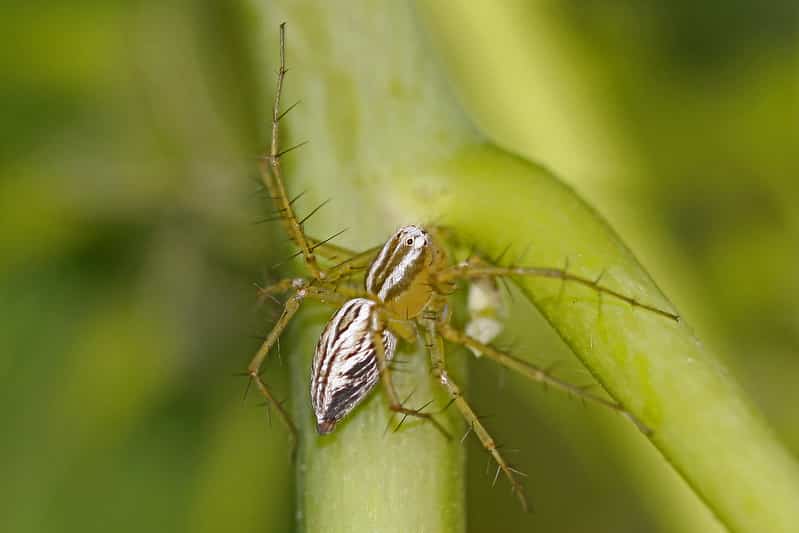
Lynx Spiders have relatively longer fangs than their head. They have spines on their legs and a long abdomen. With six similar eyes of similar size arranged in a hexagonal manner on top of their head, they also have a pair of eyes smaller than the other lying under this hexagon.
The females have a 5.6-6.8 mm long body with a pale yellow-colored head with bands of dark colors on their upper body. The males have a distinctive copper-colored head. Their abdomen, which is covered with iridescent scales, appears silvery green or purple in color. The males are usually smaller than the female lynx spiders.
Striped Lynx aren’t dangerous to humans. However, their bite can cause pain and swell with 7″-10″ in diameter.
These spiders live in areas with moist and tall grass meadows in the forest, Woodlands, and heathlands. Lynx are native to North America. Also distributed generously in the population in eastern Australia, Striped Lynx Spiders are sure one of the most beautiful spiders on the list.
12.Grass Spiders
The dorsal markings on the carapace and abdomen and elongated hind spinnerets can be easily identified. This makes spotting a Grass Spider marvelously easy.
Their abdomen has darker median bands than the carapace, at times with a scalloped edge. The size of the females varies from 10-20mm in length, whereas the males have 9-18mm body length. Their carapace has yellow-brown to brown coloration, including a pair of darker bands extending back and a pair of thin lines on each side of the carapace.
The Grass Spiders do release venom, but they aren’t poisonous. They use their venom to subdue their prey.
Preferring flight to fight, they are shy spiders who bite only when they feel threatened. The basic symptoms of their bite are swelling and redness.
Grass Spiders are not capable of building a strong web above the ground, so they inhabit areas with tall grass, shrubby areas, and low lying bushes. They are most commonly found in the United States.
13.Gray Wall Jumper
Gray Wall Jumper is a jumping spider species with short, dense, and grayish-white hairs covering most parts of their body. They have a brown body with dorsal stripes in black color.
The stripes on either side of their abdomen are brownish-white. They have black and white bands on their legs with thick black abdominal bands. These are medium-sized spiders with an average size of 7-10mm.
Gray Wall Jumper spiders bite only when they are provoked, and their venom isn’t harmful to humans unless someone (or you) is allergic.
Gray Wall Jumpers inhabit mainly man-made structures like buildings, houses, fences, etc., and they also can be found on tree trunks stalking their prey. They are found in many different countries like Brazil, India, South Africa, and the United States.
14.Velvet Spider
As the name goes, these spiders have got thick and glossy hairs that look similar to velvet. They are found in different bright colors like black, red, white, brown, and orange with black spots like a ladybird. On average, the female velvet spiders grow to a height between 0.47-0.59 in, and males are slightly smaller in size. They can live for almost five years.
Though they look dangerous, they aren’t really; their venom has no effect on humans. Their venom is potent only for killing small insects.
Velvet Spiders are found in different parts of Europe, Asia, and Africa. These spiders live under the rocks, logs, and other objects lying on the ground.
15.American House Spider
The American House Spiders are known for their identical long skinny legs. The comb-like hairs on their ankles give them a distinct appearance. Their bulbous abdomen is brown colored with white and dark spots and linings. The whole body is covered with different patterns of different shades, which give them a vaguely spotted appearance.
Talking of camouflage, they easily blend in the background, given their physical characteristics.
Female American House Spiders are bigger than males, and these spiders can be 2.6cm in size, but their average size is 6mm long.
They do carry venom, with the help of which they paralyze their prey, but their venom is not dangerous for humans; a bite, however, might cause an itchy bump and redness.
American House Spiders prefer places with dark and most environments. One can easily find them in their basements, attics, under furniture, and closets.
FAQs
Which is the deadliest spider in the world?
The Brazilian Wandering Spider, a large brown, has a neuroactive venom that is the most lethal of all arachnids in the world. In children, especially the ones with weaker immune systems, these spiders are known to have caused death within minutes of releasing venom.
Are Striped Spiders poisonous?
Not usually. Stripes don’t have anything to do with the toxicity of a spider or whether it is a danger to humans or not. Most striped spiders are either deprived of venom or contain mild venom that only subdues small prey such as insects.
Can Tarantulas kill humans?
The one myth that needs an air of clarity is that the ‘venomous bite’ of tarantulas can kill a human. When intimidated or provoked, they usually bite without injecting venom, which is no more painful than a bee sting.
Even if they do inject venom, it has never been reported to be lethal to humans to date.
Which is the most beautiful spider in the world?
The Peacock Parachute Spider is indeed the most mesmerizing spider in the world. This species of tarantula, also known as the Gooty Sapphire ornamental, has a beautiful blue hairy body with white stripes on the knees.
Although it can deliver a painful bite, it is only endemic to a small part of India, which also makes it highly rare.
Which is the most common spider in the USA?
The most common spider in the US is, of course, the American House Spider with long skinny legs and a comb-textured body.
Which is the rarest spider in the world?
Hogna ingens, aka the Desert Wolf Spiders, are unfortunately the rarest and most critically endangered spiders in the world. Suggested through their names, these spiders are endemic to the Desert Island in Portugal. However, the recent birth of 500 spiderlings of these species in a zoo has brought a huge relief for now.






